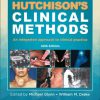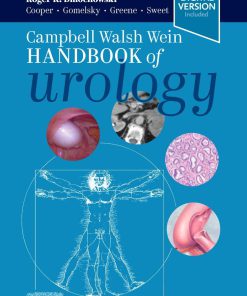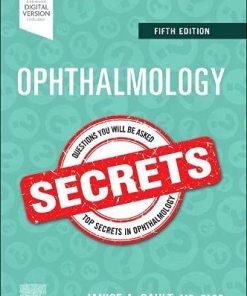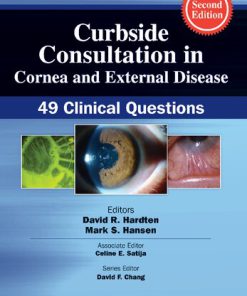Campbell Walsh Wein Handbook of Urology 1st Edition by Alan W Partin, Louis R Kavoussi, Craig A Peters, Roger R Dmochowski ISBN 0323827470 9780323827478
$50.00 Original price was: $50.00.$25.00Current price is: $25.00.
Campbell Walsh Wein Handbook of Urology 1st Edition by Alan W Partin, Louis R Kavoussi, Craig A Peters, Roger R Dmochowski – Ebook PDF Instant Download/Delivery: 0323827470, 9780323827478
Full download Campbell Walsh Wein Handbook of Urology 1st Edition after payment

Product details:
ISBN 10: 0323827470
ISBN 13: 9780323827478
Author: Alan W Partin, Louis R Kavoussi, Craig A Peters, Roger R Dmochowski
Campbell Walsh Wein Handbook of Urology 1st Edition Table of contents:
1 Evaluation of the urologic patient: History, physical examination, laboratory tests, imaging, and hematuria workup
Contributors of Campbell-Walsh-Wein, 12th Edition
Patient history and physical examination
Clinic visit set-up
Patient history
Chief complaint (CC)
History of present illness (HPI)
Constitutional symptoms.
Pain.
Hematuria.
Lower urinary tract symptoms (LUTS).
Urinary incontinence
Erectile dysfunction (ED).
Other urologic conditions.
Past medical/surgical history
Performance status
Medications
Social history
Family history
Review of systems
Physical examination
Vital signs
General appearance
Kidneys
Bladder
Penis
Scrotum and contents
Digital rectal examination (DRE)
Pelvic examination in the female
Laboratory tests
Urinalysis
UA evaluation
Specific gravity and osmolality.
pH.
Blood/hematuria.
Leukocyte esterase (LE) and nitrite.
Bacteria.
Yeast.
Protein.
Glucose and ketones.
Bilirubin and urobilinogen.
Urine cytology
Serum studies
Creatinine and glomerular filtration rate (GFR)
Prostate-specific antigen (PSA)
Alpha-fetoprotein (AFP), human chorionic gonadotropin (HCG), and lactate dehydrogenase (LDH)
Endocrinologic studies
Parathyroid hormone
Office diagnostic procedures
Uroflowmetry
Post void residual (PVR)
Cystometography and urodynamic studies
Cystourethroscopy
Imaging of the urinary tract
Plain abdominal radiography.
Retrograde pyelogram (RPG).
Loopography.
Retrograde urethrography.
Voiding cystourethrogram (VCUG).
Functional imaging with nuclear scintigraphy
Technetium 99m –diethylenetriamine pentaacetic acid (99m TC-DTPA)
Technetium 99m –dimercaptosuccinic acid (99m TC-DMSA)
Technetium 99m -mercaptoacetyltriglycine (99m TC-MAG3)
Diuretic scintigraphy
Phamacokinetics.
Phases of dynamic renal imaging.
Urologic ultrasonography
Renal ultrasonography.
Bladder ultrasonography.
Scrotal ultrasonography.
Ultrasonography of the penis and male urethra.
Transperineal/translabial ultrasound.
Transrectal ultrasonography of the prostate (TRUS).
Urologic computed tomography (CT)
Types of CT.
Hounsfield units (HU).
Urolithiasis.
Cystic and solid renal masses.
Urologic magnetic resonance imaging (MRI)
Adrenal MRI.
Renal MRI.
Urothelial cell carcinoma (upper and lower tract).
Prostate MRI.
Nuclear medicine in urology
Whole-body bone scan.
Positron emission tomography (PET).
Hematuria
Causes of microscopic hematuria
Selecting patients for evaluation
Guideline-based evaluation of microscopic and gross hematuria
Lower tract evaluation
Upper tract evaluation
Suggested readings
2 Principles of urologic surgery: Perioperative management
Contributors of Campbell-Walsh-Wein, 12th Edition
Preoperative evaluation
History
Physical exam
Functional assessment
Preoperative education
Risk stratification tools
Preoperative tests
Optimization of preoperative comorbidities
Cardiac
Pulmonary
Smoking.
Obstructive sleep apnea.
Hepatobiliary
Endocrine
Diabetes.
Hypothyroidism.
Chronic steroid use.
Neurologic
Perioperative considerations
Antithrombotic therapy
Antiplatelet agents.
Anticoagulants.
Nutrition
Bowel prep
Intraoperative considerations
Antibiotic prophylaxis
Skin preparation
Positioning
Anesthesia
Regional anesthesia.
Monitored anesthesia care.
General anesthesia.
Normothermia
Blood transfusion
Transfusion reactions.
Infection risk.
Special situations.
Hemostatic agents.
Radiation safety
Intraoperative technical decisions
Incisions
Suture
Drains
Catheters
Stents
Nephrostomy tubes
Fascial closure
Wound closure
Postoperative management
Venous thromboembolism (VTE) prophylaxis
Pain management
Multimodal pain control.
Narcotics.
Gastrointestinal (GI) recovery
Delirium
Special populations
Pregnancy
Radiation exposure.
Surgical principles.
Morbid obesity
Geriatric
Suggested readings
3 Principles of endourology and fundamentals of laparoscopic and robotic urologic surgery
Contributors of Campbell-Walsh-Wein, 12th Edition
Cystoscopy preparation and tips
Ureteroscopy tips and key points
Special circumstances
Suprapubic cystotomy
Continent urinary diversions
Fundamentals of laparoscopic and robotic urologic surgery
Achieving transperitoneal access and establishing pneumoperitoneum
Closed technique (veress needle).
Open access technique: Hasson technique.
Hand port access.
Achieving retroperitoneal access and developing the retroperitoneal space
Limitations
Advantages
Physiologic considerations
Troubleshooting in laparoscopic and robotic surgery
Suggested readings
4 Urologic Evaluation of the Child
Contributors of Campbell-Walsh-Wein, 12th Edition
History
Physical examination
Examining the pediatric patient (Table 4.1) testicular exam
Female perineal exam
Assessing the neuromuscular system
Laboratory testing
Urinalysis
Urine culture
Urinary flow rate
Flow-electromyography studies
Urodynamics
Imaging (Tables 4.2 and 4.3)
Renal and bladder ultrasound
Testicular ultrasound
Cystography, pyelography, and urogenitography
Nuclear medicine imaging
Radionuclide cystography.
DMSA.
MAG-3 diuretic renography.
Computed tomography imaging
Magnetic resonance urography
Incidental and prenatal imaging findings
Kidney
Congenital malformations.
Hydronephrosis.
Clinical presentation
Symptoms
Dysuria
Hematuria
Incontinence
Scrotal pain
Urinary retention
Penile pain
Flank pain or colic
Physical findings
Male genitalia
Penis
Swelling and erythema.
Prolonged erection.
Meatal size abnormalities.
Lesions.
Abnormal shape.
Urethral abnormalities.
Scrotum
Swelling.
Fluid or solid.
Tenderness.
Erythema.
Undescended testicles.
Female genitalia
Interlabial mass (see Table 4.8)
Urethral mass.
Paraurethral mass.
Vaginal mass.
Vaginal opening absent
Labial adhesions.
Imperforate hymen.
Cloacal anomaly.
Abnormal clitoris and pubis
Female epispadias.
Ambiguous genitalia
Major structural abnormalities
Epispadias–exstrophy complex.
Prune Belly syndrome.
Suggested readings
5 Urinary tract infections and vesicoureteral reflux
Contributors of Campbell-Walsh-Wein, 12th Edition
Evaluation and management of a child with a fever
Definition of a urinary tract infection
Pathogenesis of UTI development
Risk factors leading to pediatric urinary tract infections
Gender and age.
Circumcision.
Anatomic abnormalities.
Vesicoureteral reflux (VUR).
Sexual activity.
Bladder and bowel dysfunction (BBD).
Iatrogenic factors.
Biofilms
Classification of pediatric urinary tract infections
Cystitis and pyelonephritis
Asymptomatic bacteriuria (ASB)
Bacterial nephritis
Pyonephrosis
Acute renal abscess
Diagnosing a pediatric urinary tract infection
Symptoms
Physical examination
Urine collection methods.
Urine dipstick tests.
Urine culture.
Radiographic imaging
Controversies with imaging strategies.
Ultrasound.
Voiding cystourethrogram.
99mTC-dimercaptosuccinic acid (DMSA) scan.
Computed tomography (CT).
Management of pediatric urinary tract infection
Antibiotic treatment
Inpatient versus outpatient management
Antibiotic duration
Antibiotic selection
Management after urinary tract infection
Chronic prophylactic antibiotics (CAPS)
Bladder and bowel dysfunction (BBD)
Vesicoureteral reflux
Etiology of VUR.
Spontaneous resolution.
Principles of management.
Medical management
Surgical management
Associated anomalies and conditions with VUR
Ureteropelvic junction obstruction (UPJO)
Ureteral duplication
Bladder diverticula
Renal anomalies
Megacystis-megaureter association
Pregnancy and reflux
Renal scars
Suggested readings
6 Lower urinary tract dysfunction and anomalies in children
Contributors of Campbell-Walsh-Wein, 12th Edition
Lower urinary tract and bowel dysfunction in children
Epidemiology and pathophysiology
Clinical presentation
Diagnosis and testing
Treatment
Prognosis
Pediatric bladder anomalies
Posterior urethral valves
Epidemiology and pathophysiology
Clinical presentation
Neonatal presentation.
Delayed presentation.
Diagnosis and testing
Prenatal diagnosis.
Postnatal diagnosis.
Treatment
Prenatal management.
Postnatal management.
Prognosis
Bladder exstrophy
Epidemiology and pathophysiology
Clinical presentation
Diagnosis and testing
Prenatal diagnosis.
Postnatal testing.
Treatment
Postnatal management.
Surgical repair.
Prognosis
Prune belly syndrome
Epidemiology and pathophysiology
Clinical presentation
Diagnosis and testing
Prenatal diagnosis.
Spectrum of disease.
Postnatal testing.
Treatment
Postnatal management.
Surgical repair.
Prognosis
Neuromuscular dysfunction of the lower urinary tract in children
Epidemiology and pathophysiology
Clinical presentation
Diagnosis and testing
Prenatal diagnosis.
Postnatal testing.
Treatment
Prenatal management.
Postnatal management.
Prognosis
Lower urinary tract reconstruction in children
Suggested readings
7 Congenital anomalies of the upper urinary tract: Upj obstruction, duplication anomalies, ectopic ureter, ureterocele, and ureteral anomalies
Contributors of Campbell-Walsh-Wein, 12th Edition
Congenital renal anomalies
Renal agenesis
Horseshoe kidney
Cross-fused ectopic kidney
Renal duplication anomalies
Renal obstruction: Key principles
UPJ obstruction
Definition
Presentation
Evaluation
Management
Conservative management.
Surgical management.
Ureterovesical junction obstruction
Definition
Presentation
Evaluation
Management
Conservative management.
Temporizing management.
Definitive management.
Ureterocele
Definition
Presentation
Evaluation
Management
Conservative management.
Surgical management.
Ectopic ureter
Definition
Presentation
Evaluation
Management
Conservative management.
Temporizing management.
Definitive management.
Renal cystic disease
Multicystic dysplastic kidney
Polycystic kidney disease
Juvenile nephronophthisis or medullary cystic kidney disease
Von Hippel-lindau syndrome
Calyceal diverticulum
Suggested readings
8 Management of pediatric kidney stone disease
Contributors of Campbell-Walsh-Wein, 12th Edition
Epidemiology of pediatric kidney stone disease
Evaluation
Evaluation of child with suspected nephrolithiasis
Medical history
Metabolic investigation
Urine metabolic abnormalities
Management of children and adolescents with kidney and ureteral stones
Medical expulsion therapy
Surgical management
Options for surgical management.
Radiation risks associated with surgical management.
Surgical antibiotic prophylaxis.
Ureteroscopic management of upper urinary tract calculi.
Shock wave lithotripsy.
Percutaneous nephrolithotomy.
Laparoscopic and robotic-assisted pyelolithotomy.
Medical management of pediatric kidney stones (secondary prevention)
Dietary measures
Pharmacotherapy
Suggested readings
9 Conditions of the external genitalia
Contributors of Campbell-Walsh-Wein, 12th Edition
Female
External
Labial adhesions
Urethral prolapse (Fig. 9.1)
Paraurethral cyst
Gartner’s duct cyst
Vagina
Imperforate hymen (Fig. 9.2)
Hymenal skin tags
Vaginal septum
Vaginal atresia
Vaginal agenesis
Vaginal rhabdomyosarcoma (Fig. 9.3)
Clitoris
Clitoral hypertrophy
Prolapsed ureterocele (Fig. 9.4)
Urogenital sinus/cloacal anomaly
Inguinal hernia
Male
Penis
Phimosis
Paraphimosis (Fig. 9.5B)
Smegma
Circumcision
Glanular adhesions and penile skin bridges
Meatal stenosis
Parameatal cyst
Balanitis xerotica obliterans (BXO). Lichen sclerosus ET atrophicus
Inconspicuous penis, including buried/hidden penis, trapped and webbed penis (Fig. 9.6)
Penile curvature (chordee)
Penile torsion
Congenital hemangioma
Genital lymphedema
Hypospadias
Two-staged repairs.
Complications (Table 9.1)
Epispadias
Penile and urethral abnormal size or number
Priapism
Testis and scrotum
Penoscrotal transposition and bifid scrotum
Inguinal hernia (Fig. 9.9)
Communicating hydrocele
Hydrocele of the spermatic cord and scrotal hydrocele
Abdominoscrotal hydrocele
Cryptorchidism (Fig. 9.10)
Scrotal pain/acute scrotum (Box 9.1)
Torsion of appendix testis
Testicular torsion
Extravaginal – infants
Epididymitis
Varicocele
Epididymal cyst/spermatocele
Congenital absence of the vas deferens
Suggested readings
10 Disorders of sexual development
Contributors of Campbell-Walsh-Wein, 12th Edition
Normal sexual development
Terminology and definitions
Diagnosis and management in the newborn with ambiguous genitalia
History
Physical examination
Further evaluation
Management
Diagnosis and management for the older child with suspected DSD
Pathophysiology, presentation, evaluation and management of specific DSD
Disorders of gonadal differentiation and development
Klinefelter syndrome
46,XX male.
Gonadal dysgenesis.
Turner syndrome
46,XX “pure” gonadal dysgenesis
Mixed gonadal dysgenesis (MGD)
Partial gonadal dysgenesis
46,XY complete “pure” gonadal dysgenesis (swyer syndrome)
Embryonic testicular regression and bilateral vanishing testes syndrome
Ovotesticular DSD
46,XX DSD
Congenital adrenal hyperplasia
46,XX DSD secondary to increased maternal androgens
46,XY DSD
Leydig cell aplasia (luteinizing hormone receptor abnormality)
Disorders of testosterone biosynthesis
Disorders of androgen-dependent target tissue
Syndrome of complete androgen insensitivity (CAIS)
Syndrome of partial androgen resistance (PAIS)
Mild androgen insensitivity syndrome (MAIS)
5α-reductase deficiency
Persistent müllerian duct syndrome (PMDS)
Unclassified DSD
Mayer rokitansky küster hauser syndrome (MRKH)
Suggested readings
11 Pediatric urologic oncology
Contributors of Campbell-Walsh-Wein, 12th Edition
Adrenal tumors
Neuroblastoma
Symptoms.
History.
Examination.
Labs.
Imaging.
Differential diagnosis.
Treatment.
Prognosis.
Pheochromocytoma
Symptoms.
History.
Examination.
Labs.
Imaging.
Differential diagnosis.
Treatment.
Prognosis.
Renal tumors (Figs. 11.3 and 11.4) (Table 11.2)
Wilms tumor (nephroblastoma)
Symptoms.
History.
Examination.
Labs.
Imaging.
Differential diagnosis.
Treatment.
Prognosis.
Renal cell carcinoma
Symptoms.
History.
Examination.
Labs.
Imaging.
Differential diagnosis.
Treatment.
Prognosis.
Bladder and prostate tumors
Rhabdomyosarcoma
Symptoms.
History.
Examination.
Labs.
Imaging.
Differential diagnosis.
Treatment.
Prognosis.
Gynecologic tumors
Gynecologic rhabdomyosarcoma
Symptoms.
History.
Examination.
Labs.
Imaging.
Differential diagnosis.
Treatment.
Prognosis.
Testicular and paratesticular tumors
Testicular germ cell tumors (GCTS)
Symptoms.
History.
Examination.
Labs.
Imaging.
Differential diagnosis.
Treatment.
Prognosis.
Testicular stromal tumors (leydig cell tumor, sertoli cell tumor, granulosa cell tumors)
Symptoms.
History.
Examination.
Labs.
Imaging.
Differential diagnosis.
Treatment.
Prognosis.
Paratesticular rhabdomyosarcoma
Symptoms.
History.
Examination.
Labs.
Imaging.
Differential diagnosis.
Treatment.
Prognosis.
Suggested readings
12 Infections and inflammatory conditions of the genitourinary system
Contributors of Campbell-Walsh-Wein, 12th Edition
Urinary tract infections
Asymptomatic bacteriuria (AB)
Antimicrobial therapy.
Uncomplicated cystitis
Complicated utis
Emphysematous cystitis (EC).
Recurrent utis
Acute pyelonephritis
Renal abscess
Perinephric abscess
Xanthogranulomatous pyelonephritis (XGP)
Emphysematous pyelonephritis (EP)
Acute orchitis and epididymitis
Fournier gangrene
Gonococcal urethritis
Nongonococcal urethritis (Fig. 12.13)
Chlamydial urethritis
Mycoplasma genitalium
Trichomonas vaginalis
Anogenital warts (condyloma acuminatum)
Genitourinary tuberculosis (TB)
Interstitial cystitis
Suggested readings
AUA guidelines
13 Male infertility
Contributors of Campbell-Walsh-Wein, 12th Edition
Epidemiology
Pathophysiology
Clinical manifestations
Diagnosis and testing
Treatment
Prognosis
Suggested readings
People also search for Campbell Walsh Wein Handbook of Urology 1st Edition:
james campbell handbook
campbell walsh urology pdf download
campbell walsh wein urology
campbell walsh handbook urology
campbell’s urology online
Tags: Alan W Partin, Louis R Kavoussi, Craig A Peters, Roger R Dmochowski, Campbell Walsh Wein
You may also like…
Medicine - Clinical Medicine
Medicine - Ophthalmology
Uncategorized
Medicine - Surgery











